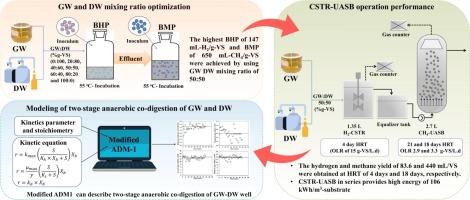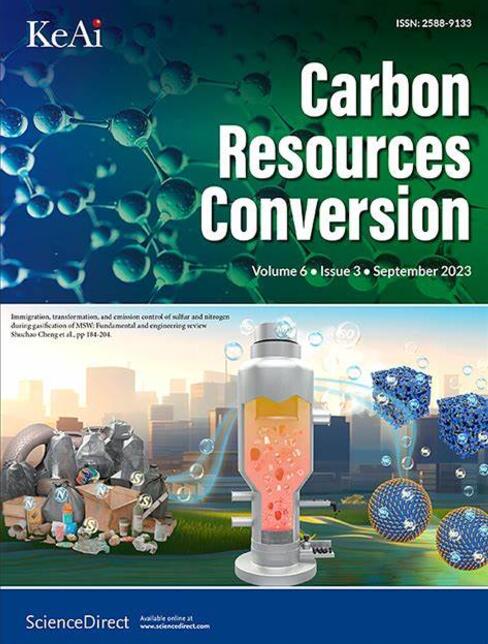Anaerobic co-digestion of glycerol waste and distillery wastewater for bio-hythane production: Performance and ADM-1 based kinetics
IF 7.5
3区 环境科学与生态学
Q2 ENERGY & FUELS
引用次数: 0
Abstract
Glycerol waste (GW), with its high carbon content, was co-digested with nitrogen-rich distillery wastewater (DW) in this experiment to evaluate hydrogen and methane production in a two-stage anaerobic digestion (AD) system. Bio-hydrogen potential (BHP) and methane potential (BMP) were conducted under thermophilic conditions (55°C) for the co-digestion of GW and acetone-butanol-ethanol distillery wastewater (ABE-DW) at various mixing ratios of 0:100, 20:80, 40:60, 50:50, 60:40, 80:20, and 100:0 (%VS) to determine the optimal mixing ratio. The highest BHP of 147 mL-H2/g-VS and BMP of 650 mL-CH4/g-VS were achieved at a GW to ABE-DW mixing ratio 50:50. Then. the process proceded with the continuous two-stage anaerobic process which was later implemented with the continuously stirred tank reactor (CSTR) for hydrogen production and the up-flow anaerobic sludge blanket (UASB) reactor for methane production in order to assess system performance. A mixture of GW and DW from commercial ethanol production (ethanol-DW) at a 50:50 mixing ratio was fed into the CSTR at a 4-day HRT, and the CSTR effluent was subsequently fed into the UASB at 21-day and 18-day HRTs. The CSTR achieved a hydrogen yield of 83.6 mL-H2/g-VS, while methane yields in the UASB were 367 mL-CH4/g-VS at a 21-day HRT and 440 mL-CH4/g-VS at an 18-day HRT. Additionally, the original ADM-1 was modified to describe the two-stage anaerobic co-digestion of GW and DW. This enhanced model effectively predicts the performance of the two-stage anaerobic process for co-digesting GW and DW.

甘油废物和蒸馏废水厌氧共消化用于生物乙烷生产:性能和基于ADM-1的动力学
以含碳量高的甘油废渣(GW)与富氮蒸馏废水(DW)共消化为研究对象,对两级厌氧消化(AD)系统的产氢产甲烷效果进行了评价。在55℃的高温条件下,以0:100、20:80、40:60、50:50、60:40、80:20和100:0 (%VS)的混合比例,对GW和丙酮-丁醇-乙醇蒸馏废水(ABE-DW)进行生物氢势(BHP)和甲烷势(BMP)测定,确定最佳混合比例。当GW与ABE-DW的混合比为50:50时,BHP达到147 mL-H2/g-VS, BMP达到650 mL-CH4/g-VS。然后。该工艺采用连续两级厌氧工艺,随后采用连续搅拌槽式反应器(CSTR)生产氢气和上流式厌氧污泥毯式反应器(UASB)生产甲烷,以评估系统性能。在4天的HRT下,将商业乙醇生产的GW和DW(乙醇-DW)按50:50的混合比例送入CSTR,随后在21天和18天的HRT下,将CSTR出水送入UASB。CSTR的氢气产量为83.6 mL-H2/g-VS,而UASB的甲烷产量在21天的HRT下为367 mL-CH4/g-VS,在18天的HRT下为440 mL-CH4/g-VS。此外,对原来的ADM-1进行了修改,以描述GW和DW的两阶段厌氧共消化。该增强模型有效地预测了两级厌氧工艺共消化GW和DW的性能。
本文章由计算机程序翻译,如有差异,请以英文原文为准。
求助全文
约1分钟内获得全文
求助全文
来源期刊

Carbon Resources Conversion
Materials Science-Materials Science (miscellaneous)
CiteScore
9.90
自引率
11.70%
发文量
36
审稿时长
10 weeks
期刊介绍:
Carbon Resources Conversion (CRC) publishes fundamental studies and industrial developments regarding relevant technologies aiming for the clean, efficient, value-added, and low-carbon utilization of carbon-containing resources as fuel for energy and as feedstock for materials or chemicals from, for example, fossil fuels, biomass, syngas, CO2, hydrocarbons, and organic wastes via physical, thermal, chemical, biological, and other technical methods. CRC also publishes scientific and engineering studies on resource characterization and pretreatment, carbon material innovation and production, clean technologies related to carbon resource conversion and utilization, and various process-supporting technologies, including on-line or off-line measurement and monitoring, modeling, simulations focused on safe and efficient process operation and control, and process and equipment optimization.
 求助内容:
求助内容: 应助结果提醒方式:
应助结果提醒方式:


